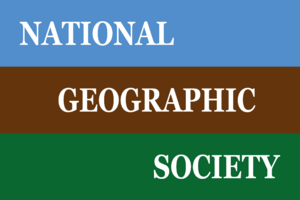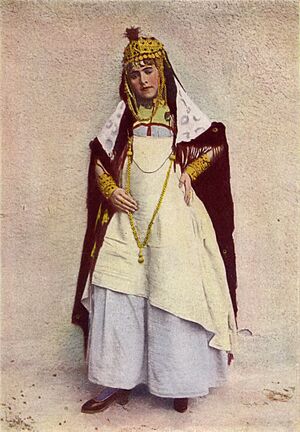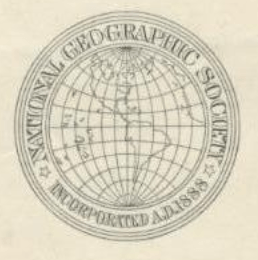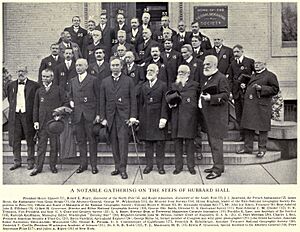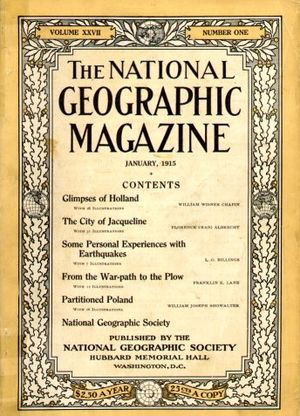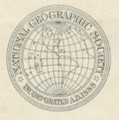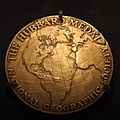National Geographic Society facts for kids
 |
|
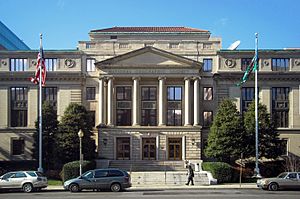
The National Geographic Society's Administration Building in Washington, D.C.
|
|
| Formation | January 13, 1888 |
|---|---|
| Type | 501(c)(3), charitable organization |
| Purpose |
|
| Headquarters | 1145 17th Street Washington, D.C., U.S. |
|
Region served
|
Worldwide |
|
Chairman
|
Jean M. Case |
|
CEO
|
Jill Tiefenthaler |
|
Main organ
|
Board of Trustees |
| Subsidiaries | National Geographic Partners (27%) |
The National Geographic Society is a huge non-profit group based in Washington, D.C., USA. It's one of the biggest science and education organizations in the world.
It started in 1888. Its main goals are to explore and teach people about geography, archaeology, and natural science. It also works to protect the environment and historical places. The Society helps people learn about different cultures and history around the globe. You can spot its famous yellow rectangular logo on its magazines and TV channels. The Society works with The Walt Disney Company through a partnership called National Geographic Partners. This partnership helps create the magazine, TV channels, a website, and many other media projects.
Contents
About the National Geographic Society
The National Geographic Society was created on January 13, 1888. Its goal was "to increase and spread geographic knowledge." A group of 33 trustees, including teachers, business leaders, and conservationists, guides the organization.
The Society supports and funds scientific research and exploration. It also has a museum in its Washington, D.C., headquarters that is open to the public. National Geographic has helped create popular traveling exhibits, like the "King Tut" exhibit. This exhibit showed amazing items from the tomb of the young Egyptian Pharaoh. The Education Foundation gives money to groups and people who want to make geography education better. The Committee for Research and Exploration has given over 11,000 grants for scientific research and exploration.
The Society's media part is called National Geographic Partners. This is a joint effort with The Walt Disney Company. It publishes the National Geographic magazine in English and nearly 40 other languages. It also publishes other magazines, books, school materials, maps, and online videos. National Geographic's media reaches more than 280 million people every month. Many people and groups support its work, including the Leonardo DiCaprio Foundation and the Gates Foundation.
History of National Geographic
The National Geographic Society began as a club for smart people and wealthy supporters who loved travel and exploration. On January 13, 1888, 33 explorers and scientists met in Washington, D.C. They wanted to create "a society for the increase and spread of geographical knowledge." Two weeks later, on January 27, the National Geographic Society officially started. Gardiner Greene Hubbard became its first president. His son-in-law, Alexander Graham Bell, who helped invent the telephone, took over as president in 1897.
In 1899, Bell's son-in-law, Gilbert Hovey Grosvenor, became the first full-time editor of National Geographic magazine. He later became the Society's president in 1920. Grosvenor and Bell came up with the idea of Society membership. They also started using many photographs to tell stories in the magazine. This made the magazine very popular. Members of the Grosvenor family have continued to play important roles in the organization.
Currently, Jean Case is the chairman of the National Geographic Society. Jill Tiefenthaler is the chief executive officer. Gilbert Melville Grosvenor, a former chairman, received a special award in 2005 for his work in geography education.
In 2004, the National Geographic Society Headquarters building in Washington, D.C., was one of the first to get a "Green" certification. This means it was recognized for being environmentally friendly. In 2006, National Geographic received the important Prince of Asturias Award in Spain.
National Geographic Expeditions started in 1999. It helps people explore the world, and the money earned goes back to support the Society's mission.
In 2015, the Society changed how it managed its media. It created a new company called National Geographic Partners. This company is mostly owned by The Walt Disney Company (73%) and partly by the Society (27%). This new company now handles National Geographic magazine, other magazines, and its TV channels. In 2023, National Geographic announced that its magazine would no longer be sold at physical newsstands in the United States in 2024. The company stated it would continue to publish a monthly magazine using freelance writers and its remaining editors.
Original Founders of the Society
Here are the 33 people who originally founded the National Geographic Society in 1888:
- Cleveland Abbe
- Frank Baker
- Marcus Baker
- John Russell Bartlett
- Charles J. Bell
- Rogers Birnie
- William Dall
- Arthur Powell Davis
- Clarence Dutton
- Henry Gannett
- Samuel Gannett
- Grove Karl Gilbert
- George Brown Goode
- James Howard Gore
- Adolphus Washington Greely
- Edward Everett Hayden
- Henry Wetherbee Henshaw
- Gardiner Greene Hubbard
- Willard Drake Johnson
- George Kennan
- George Wallace Melville
- Clinton Hart Merriam
- Henry Mitchell
- Robert Muldrow II
- Herbert Gouverneur Ogden
- John Wesley Powell
- William Bramwell Powell
- Israel Russell
- Winfield Scott Schley
- Almon Harris Thompson
- Gilbert Thompson
- Otto Hilgard Tittmann
- James Clarke Welling
Even though Alexander Graham Bell is often mentioned, he was actually the second president, not one of the original founders. He became president in 1898.
What National Geographic Does
Supporting Research and Exploration
The Society has helped fund many expeditions and research projects over the years. These projects explore different parts of the world and study various scientific topics.
Special Awards
Hubbard Medal
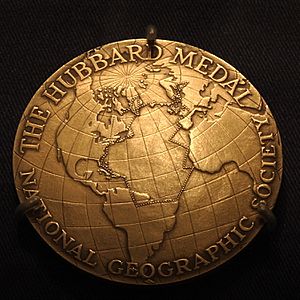
The Hubbard Medal is a special award given by the National Geographic Society. It honors people who have made great achievements in exploration, discovery, and research. The medal is named after Gardiner Greene Hubbard, the Society's first president. As of 2018, the Hubbard Medal has been given 44 times. The most recent award went to Peter H. Raven.
Alexander Graham Bell Medal
The National Geographic Society also sometimes gives out the Alexander Graham Bell Medal. This award is for amazing contributions to geographic research. It is named after Alexander Graham Bell, who was a scientist, inventor of the telephone, and the Society's second president. This medal has been given out twice:
- 1980: Bradford Washburn and his wife Barbara Washburn
- 2010: Roger Tomlinson and Jack Dangermond
National Geographic Museum
The Society runs the National Geographic Museum in Washington, D.C. The museum has changing exhibits that show the work of National Geographic explorers, photographers, and scientists. There are also exhibits about natural history, different cultures, and history. Some permanent exhibits include the camera Robert Peary used at the North Pole and pottery found by Jacques Cousteau from a shipwreck.
National Geographic Explorers Program
The National Geographic Society calls certain people "Explorers." These are amazing individuals in their fields who get money and support from the Society. They work to understand and protect our world through science, exploration, education, and storytelling. These explorers include scientists, photographers, and filmmakers.
Publications
National Geographic Magazine
The National Geographic Magazine first came out in October 1888. It was the Society's official journal. In 1910, the magazine started using its famous yellow border on the covers.
There are 12 issues of National Geographic each year. The magazine has articles about geography, science, world history, culture, current events, and amazing photos from all over the world. National Geographic magazine is now published in 40 different languages in many countries. About 6.8 million copies are sold each month, reaching around 60 million readers.
Other Publications
Besides its main magazine, the Society publishes other magazines:
- National Geographic Explorer: This is a magazine for classrooms. It replaced National Geographic World in 2001.
- National Geographic History: This magazine started in 2015 and focuses on history.
- National Geographic Kids: This is a version of National Geographic Magazine made for children. It started in 1975 as National Geographic World. It sells over 1.5 million copies in the U.S. and has 18 other language editions.
- National Geographic Little Kids: This magazine is for younger children, aged 3 to 6.
- National Geographic Traveler: This magazine started in 1984 and focuses on travel. It has 18 other language editions.
The Society also publishes atlases, books, and maps through National Geographic Books and National Geographic Maps. These are part of National Geographic Partners.
Films and Television
National Geographic Films
National Geographic Films used to be a part of the National Geographic Society. It produced many films. In 2008, the film division worked with another company to create a $100 million fund. This fund helped develop and produce 10-15 films over five years.
Some films it has produced include:
- K-19: The Widowmaker (2002), a movie about a submarine.
- March of the Penguins (2005), a very popular film about penguins.
- Arctic Tale (2007), a film about walrus and polar bears.
- Sea Monsters (2007), a 3-D film.
- The Way Back (2010)
- Life in a Day (2011)
- The Last Lions (2011)
Television Programs
National Geographic Society also produces TV programs. These shows have been on channels like PBS and others for many years. The Geographic series started on CBS in 1964. It later moved to ABC, then PBS, NBC, and finally to the National Geographic Channel in 2005.
These shows have featured famous scientists like Jacques Cousteau, Jane Goodall, and Louis Leakey. Their work became well-known to millions of people because of these programs. The theme music for these specials, created by Elmer Bernstein, is also used by the National Geographic Channel. Another long-running show is National Geographic Explorer.
Television Channels
The Walt Disney Company's subsidiaries handle the distribution and advertising for the National Geographic-branded channels worldwide. The Society provides the programs for these channels. The National Geographic Channel has also launched other channels in different countries, such as Nat Geo Wild, Nat Geo People, and Nat Geo Kids.
The U.S. version of the National Geographic Channel started in January 2001. It was a joint project between National Geographic and Fox Cable Networks.
Music and Radio
National Geographic Music and Radio (NGMR) is the music and radio part of National Geographic. It includes live events, digital music, music publishing, and radio content. It also has the Nat Geo Music TV channel in some parts of Asia and Europe.
In recent years, NGMR has focused on digital platforms like Spotify, Apple Music, and YouTube. They share soundtracks, music from artists, and music related to National Geographic's shows.
Images for kids
See also
 In Spanish: National Geographic Society para niños
In Spanish: National Geographic Society para niños


